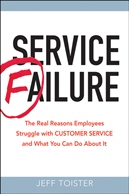Three reasons to give customer service employees a raise
 Jeff Toister
Jeff Toister  Wednesday, August 15, 2012 at 12:22PM |
Wednesday, August 15, 2012 at 12:22PM | A number of years ago, I managed the call center for a catalog company that sold a wide range of imported collectables. Our call center reps had to have a lot of knowledge about our diverse products, generally dealt with sophisticated customers who had high expectations, and were expected to handle both sales and customer service calls. You might expect to pay a little extra to attract good employees, but our company had cash flow problems. As a result, the company's owners mandated a starting wage that was in the bottom 25% for this type of position. Understandably, we had a hard time finding great people who were willing to work for so little when they could make more money doing the same job somewhere else.
Business owners instinctively want to pay their frontline customer service employees as little as possible, but what if paying low wages actually increased costs and hurt profitability?
 Research published earlier this year in the Harvard Business Review by M.I.T. Professor Zeynep Ton suggests that it may make economic sense for retailers to invest more in their employees. She studied retail chains such as Costco and Trader Joe’s that offer low prices, but have achieved high levels of profitability and customer service while paying relatively higher wages, offering more training, and staffing more employees than their competitors. (See the article here plus a related blog post.)
Research published earlier this year in the Harvard Business Review by M.I.T. Professor Zeynep Ton suggests that it may make economic sense for retailers to invest more in their employees. She studied retail chains such as Costco and Trader Joe’s that offer low prices, but have achieved high levels of profitability and customer service while paying relatively higher wages, offering more training, and staffing more employees than their competitors. (See the article here plus a related blog post.)
Of course, paying top dollar isn’t the right strategy for every business. In this post, I’m focusing on three potential benefits of paying your customer service employees more.
Reason #1: Gain Access to the Right Talent
Good employees don’t come cheaply. They tend to have more options than less skilled or poorly performing employees. The best employees are also more likely to be employed by someone else when you start searching for them. Unless you have an incredible reputation as an employer of choice, people aren’t going to take a pay cut or make a lateral move to join your organization. Offering a higher starting wage gives you access to more potential qualified candidates.
How can you tell how much to pay? Here are three things you can try:
- Create a profile of an ideal employee. (You can use my simple competency model.)
- Go to salary.com and find the salary range for the position you are trying to fill.
- Experiment with posting the same job at different rates of pay and compare the applicants you receive to your ideal employee profile. If good candidates are scarce, you may need to pay more.
Reason #2: Get Better Results, Faster
If you pay more for better employees, you should expect those employees to bring more skills, ability, and passion to the job than someone who is willing to work for less. For example, when a client of mine increased the starting rate for an open position, they were able to hire someone who needed far less training than their last hire. In less than a month, the new employee was one of their top performers. The slight increase in pay resulted in a substantial cost savings in terms of reduced training expense and productivity gains.
Will paying more yield better results? Look to these key result areas to see if it makes financial sense:
- Training. Can you save time and money by hiring someone who needs less training?
- Staffing. Can you hire fewer people by hiring someone who has a wider range of skills?
- Quality. Can a higher-caliber employee pay for themselves by making fewer errors?
Reason #3: Reduce Turnover
Good employees won’t stick around very long if they feel undervalued, especially if they can get the same job for higher wages. The real cost of employee turnover can be enormous when you factor in the cost of covering for absent employees (overtime, lost productivity, etc.) and the cost of recruiting and training new ones to take their place. Paying just a little more might be much less expensive than the high cost of employee defections.
How can you calculate the real cost of employee turnover?
- Try using this turnover cost calculator (Excel spreadsheet).
- Calculate the cost savings of a modest reduction in turnover.
- Experiment with investing some of that cost savings in higher wages.
Are employee wages the only factor? No, of course not. There is a whole list of factors that influence employee performance, engagement, and retention. However, the advantage of focusing on employee pay is it is generally easier to make the cost/benefit calculation compared to other possible strategies.




Reader Comments